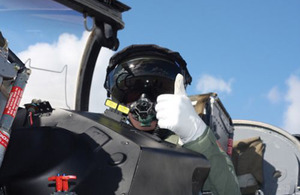Aviation medics push limits to protect RAF aircrews
Tornado GR4 crews currently deployed to Afghanistan are already benefiting from high-tech lifesaving equipment that has been tested and developed…

MOD reporter Neale Adams is ready to take off in one of the Aviation Medicine Flight's Hawk T1 jets [Picture: Blythe Story-Smith, Crown Copyright/MOD 2010]
Tornado GR4 crews currently deployed to Afghanistan are already benefiting from high-tech lifesaving equipment that has been tested and developed at the famous MOD site at Boscombe Down.
As well as the RAF CAM headquarters at RAF Henlow, there is an Aviation Medicine Flight at MOD Boscombe Down that flies two Hawk T1 jets that are specially adapted to test equipment such as pilots’ G-suits, helmets, hearing protection and oxygen systems.
Apart from the Typhoon, the Hawks are the only aircraft in the RAF which are cleared to regularly fly at 9G and were instrumental in helping to test equipment being used in the Typhoon. The Aviation Medicine Flight is also assisting with the Joint Strike Fighter programme.
But the Flight is not just about testing equipment, as it also helps aircrew combat air sickness issues or helps to rebuild their flying ability after an injury.
Officer Commanding Aviation Medicine Flight, Squadron Leader Gaz Kennedy, said:
We will trial new equipment coming into service, or modifications to existing equipment, to ensure they are ‘fit for purpose’. Helmets with new night-vision goggles for example or oxygen masks must be comfortable for the pilot and not restrict their ability to fly.
Any aircrew who suffer from air sickness or have had an injury will be referred to us through RAF CAM and we will put them through a flying programme tailored to their needs.
A pilot with a neck injury cannot immediately fly up to 9G, so we will help to build up their ability to withstand G.
The Hawks are fitted with extra data recorders and all information is retained and later analysed to weed out any problems.
So, having never been in a fast jet before and given the opportunity to fly as a passenger in the back of one of the Hawks, I duly accepted a place on the two-ship flight.
After a medical, safety brief and full flying equipment fit by the RAF Survival Equipment Fitters on the Flight, I am strapped into the Hawk by the pilot Sqn Ldr Kennedy.
Flying the other Hawk is American exchange officer Colonel Derek Knight - one of only a handful of United States Air Force (USAF) pilots/physicians.
Such is the high regard for the work of the RAF CAM by the USAF that the exchange posting is considered one of the best by the American pilots/physicians.
My excitement is tempered by absolute fear - especially after the safety brief minutes before the flight on the need to eject in certain emergencies, or the problems that follow if a bird strikes the aircraft on take off.
Again, it is the survival equipment the Aviation Medicine Flight tests that saves the lives of pilots in such situations.
Once airborne, things quickly change - in the air, it is a different world.
The aircraft banks hard as Sqn Ldr Kennedy effortlessly puts the Hawk through its paces. The G-suit I am wearing inflates to regulate the blood flow in my body as it is pushed through 4G.
A ‘barrel roll’, ‘loop’ and ‘half-Cuban’ (all flying manoeuvres where at some point the aircraft flies upside down) test both man and machine.
The two Hawks practise flying in formation and a tail chase (or follow my leader) exercise. The tail chase is one of the steps pilots take when learning air combat skills. It is the type of essential flying needed to test flying equipment or assist aircrew in rehabilitation and to keep the pilots ‘current’ in their flying skills.
This article by Neale Adams is taken from RAF News - Voice of the Royal Air Force.